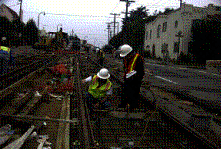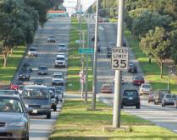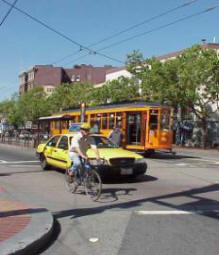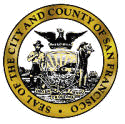San Francisco Municipal Transportation Agency (SFMTA)
www.sfmta.com
The San Francisco Municipal Transportation Agency (SFMTA) owns and operates the public transportation system and manages the traffic controls and operations for the City and County of San Francisco. SFMTA's public transportation system includes light rail vehicles, cable cars, and diesel and electric buses, operating on 80 lines, totaling over 1,000 miles. SFMTA's traffic operations and management system includes a large network of traffic signals, parking meters, signs, and street/curb markings. In addition, SFMTA's extensive CCTV cameras, fiber optic, telecommunications and wireless networks help support the City's transit and traffic operations.
Municipal Railway (Muni)

SFMTA's Municipal Railway (MUNI) has over 150 engineers and planners who plan, design and build its projects to improve and maintain SFMTA Traffic and Transportation facilities.
The MUNI has 50 active projects totaling over $2 billion. These projects provide diverse engineering opportunities for vehicle, software, control, electrical, mechanical, civil and construction engineers of sophisticated nature in the design and construction of track, SCADA, power, control and signal systems; station structures, roadways and drainage facilities.
Current programs include the Central Subway Light Rail, Bus Rapid Transit, Traffic Signal, Traffic Priority, Communications System Expansion, Intelligent Transportation System, Overhead Rehabilitation, Cable Car Infrastructure Rehabilitation, Wayside Fare Collection, Radio System Replacement, Automatic Vehicle Location System, Rail Replacement, Traction Power System Upgrades, Facilities Preservation, Bicycle Plan, and Pedestrian Plan.
Sustainable Streets Division
The Sustainable Streets Division provides multi-modal transportation planning, engineering and operational improvements to the surface transportation network to support sustainable community and economic development within the context of the Transit First Policy. SFMTA staff achieve this by closely coordinating the planning, design, engineering and construction of improvements for each mode across the City’s surface transportation network.
Transportation Engineering Section
The Transportation Engineering Section is responsible for designing, directing and managing all traffic engineering functions within San Francisco, including placement of traffic control devices, traffic striping, curb markings, and on-street parking regulations to promote the safe and efficient movement of people and goods throughout the City.
Traffic Management Group
The Traffic Management Group is primarily responsible for the parking and traffic operations in the City. Traffic Management group reviews, analyzes and implements changes to address a variety of safety, parking and traffic complaints. Traffic Management engineers conduct site investigations all over San Francisco and collect data through traffic operations-related tasks, such as traffic counts, speed surveys, parking studies, and signal timing changes. Engineers will learn and apply various techniques that can make a street safer or more efficient for the public. Engineers will gain valuable experience by working with Livable Streets and other Transportation Engineering professionals. The group also manages legislation that implements parking and traffic changes, including recommendations made by the Residential Parking Permit (RPP) and Color Curb programs.

Traffic Routing Group
The Traffic Routing Group directly supports City capital improvement projects by providing traffic routing plans, specifications, cost estimates, traffic control inspection, permits and restoration of final striping and signing for projects constructed in the public right of way. These projects include transit facility infrastructure (rail replacement), utility construction, paving, curb ramps, bulb-outs, new street and neighborhood development, streetscape projects, City park projects and SF Port projects. For key capital projects, including the Central Subway, Transbay Terminal and transit corridor projects, the Traffic Routing Group provides traffic infrastructure design and construction support, including traffic signals design, final roadway configuration/striping and roadway signing in addition to construction traffic routing plans, specifications and cost estimates.
The Traffic Routing Group also works with private builders and utility companies to establish safe work zones and issues permits to support building construction, private utility work (power, communications) and related maintenance and repair.
Special Projects and Street Use Group
The Special Projects Group is responsible for coordinating the selection process for new traffic signal, full upgrade, and minor upgrade locations, including performing conceptual traffic signal design. Engineers learn and apply signal timing and signal design principles to improve the safety and operation of the City’s signal system. Staff is involved in the entire design cycle of a traffic signal, from funding to final construction.
The Street Use group handles a variety of permits including temporary street closure permits (due to special events such as marathons, street festivals, etc.), and extralegal vehicle permits (applies to trucks whose dimensions or weight exceed the California Vehicle Code’s definition of legal vehicles).

SFgo and Transit Engineering
SFgo and Transit Engineering team is charged with improving the city’s street and signal system for transit operations. Engineers are working on a variety of projects to reduce delay to transit, including citywide transit signal priority and implementation of the Transit Effectiveness Project. Projects include changing bus zone configuration, signal timing changes, colored transit lanes, bus sidewalk bulbs, and other traffic changes. The engineers and planners in the team also provide design and engineering support to a number of projects, including Van Ness Bus Rapid Transit. SFgo staff is on the cutting edge of the latest signal technology and operates the city’s traffic message signs and cameras.
Long Range Planning and Policy
The Long Range Planning and Policy Section is responsible for asset management and optimization, multi-modal analysis and integration, corridor planning, and policy, legislative and environmental analysis. Staff members work closely with other sections throughout the SFMTA and other City agencies to coordinate projects and complete research and analysis necessary to develop multi-modal plans and strategies to improve the safety and efficiency of the transportation network to meet current and future demand.
Livable Streets
The SFMTA Livable Streets subdivision focuses on safety for bicyclists, pedestrians, and motorists. The group works on projects that promote an attractive and safe transportation experience for all.
The Pedestrian Program envisions San Francisco as becoming the most walkable city in the Country and World. Its mission is to promote walking as a sustainable and healthy mode of transportation and to reduce pedestrian collisions in San Francisco.
The Traffic Calming Program uses innovative tools to address speeding, reckless driving and traffic spillover from main arterials to local roads.
The Bicycle Program's vision is to make San Francisco the North American city with the highest per-capita bicycle use and to have a continually improving bicycle network that is safe and convenient for everyone who chooses to bicycle for transportation and recreation.
The School Area Safety Program strives to make streets near San Francisco’s public and private schools safer for walking, bicycling and public transportation.

